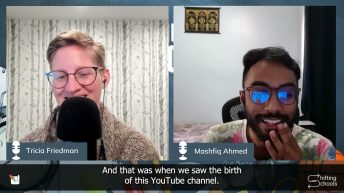|Introductions|
Clay Burell joined David and Jeff all sharing their Chinese New Year experiences from Korea, Taiwan and China.
Intro for Clay: Clay has taught language arts in the U.S., Europe, China and now Korea. He works to take “schooliness” out of his students’ learning experiences. A big part of his effort is to help his students build personal learning networks (PLN). He is now running an elective PLN focused elective course so look to follow his students’ learning via Clay’s Beyond-School blog.
|Essential Question|
Passion for learning, how to nurture and grow it?
David:
See his blog where he shares about his son’s passion for learning and what contributes to it.
Jeff:
- Finding passion in our students
- Learning needs to have meaning
- Learning needs to be authentic
- Learning needs to be deep
The SOS Team Discussion:
How to give credit for the engaging work that students want to do outside out of class? How to substitute the learning the kids are doing on their own for the prescribed classwork?
Student 2.0 writing blog that Clay initiated and continues to draw readers. Here is an excellent example of passionate learners working outside of the classroom.
Success for Clay in creating authentic learning where passionate learning takes place:
A student interviewed Clay as a minority person living in Korea. It was recorded for a podcast. It ended up being newsworthy and drew the community in to access the student’s blog and continue the discussion.
Barriers for Clay in helping his school make the shift:
Students in our high schools are often so trained in a ways that get in the way of thinking laterally and making connections that we have to “unteach” them. To create their own projects and follow their own ideas doesn’t come easy. “Give me something I can do quickly and get out of the way” is often the way our high school students operate. They often are not willing to take risks. Conclusion: We really need to start in the elementary to build a learning environment that doesn’t take the passion away.
Clay’s PLN class involves each student completing a project of personal interest that they research and then blog/podcast/vodcast about weekly. They connect to Twitter to build out their network finding people who can help them with their research. Clay finds this process to really support his hope that his students will become networked learners.
Take Away from the discussion:
One approach to shift a school is for your instructional technologist to start the year working with early adopters the first third of the year and to then move to the middle range adopters the next third of the year and to focus on the laggard group at end of the year.
It is imperative to have the instructional technologists work with groups of teachers during the school day to get buy in from the teachers. After school doesn’t work due to scheduling problems. Think about bringing in subs for a whole day. This really validates the process. Get the technical lessons (e.g., how to run a blog, use Skype, etc.) in first to remove those barriers. You can them focus on the curriculum and adapting the instruction and assessments to meet 21st century learning goals.
Teachers looking to start blogging should think about using them as their portfolios and as a way to communicate to parents and to share classroom content with students. This is a triple winner that gives teachers a real reason for using the tool. We want our students to be like trapeze artists following the flow of information moving from say Twitter to Skype then to IM then to producing one’s learning on a blog from where the conversation continues as readers comment.
Go to deeper level with our curriculum. The learning must be authentic and relevant. The kids demand it.
|Blog Posts of the Week|
Clay: Networked learning can be playful and fun at Ideas and Thoughts.
David: A home schooler shares her blueprint for passionate learning at Karen’s Blog.
Jeff: Look for rich visuals and brain-research supported posts as well as the “User Hierarchy of Needs” at Creating Passionate Users.
|Sign Off|
- Next show is Thursday February 21st. Catch it live at 7:00 PM Shanghai time.
- Our guest will be Justin Hardman from the Hong Kong International School. Check out his Blueprint: New World, New School blog.
- Essential Question for the show: How to expand the learning community to the parents?
- Don’t forget to post Web sites/blogs to the SOS Del.icio.us bookmarking site that support our upcoming EQ.




How to give credit for the engaging work that students want to do outside out of class? How to substitute the learning the kids are doing on their own for the prescribed classwork?
Student 2.0 writing blog that Clay initiated and continues to draw readers. Here is an excellent example of passionate learners working outside of the classroom.
Success for Clay in creating authentic learning where passionate learning takes place:
A student interviewed Clay as a minority person living in Korea. It was recorded for a podcast. It ended up being newsworthy and drew the community in to access the student’s blog and continue the discussion.
Barriers for Clay in helping his school make the shift:
Students in our high schools are often so trained in a ways that get in the way of thinking laterally and making connections that we have to “unteach†them. To create their own projects and follow their own ideas doesn’t come easy. “Give me something I can do quickly and get out of the way†is often the way our high school students operate. They often are not willing to take risks. Conclusion: We really need to start in the elementary to build a learning environment that doesn’t take the passion away.
Clay’s PLN class involves each student completing a project of personal interest that they research and then blog/podcast/vodcast about weekly. They connect to Twitter to build out their network finding people who can help them with their research. Clay finds this process to really support his hope that his students will become networked learners.
Take Away from the discussion:
One approach to shift a school is for your instructional technologist to start the year working with early adopters the first third of the year and to then move to the middle range adopters the next third of the year and to focus on the laggard group at end of the year.
It is imperative to have the instructional technologists work with groups of teachers during the school day to get buy in from the teachers. After school doesn’t work due to scheduling problems. Think about bringing in subs for a whole day. This really validates the process. Get the technical lessons (e.g., how to run a blog, use Skype, etc.) in first to remove those barriers. You can them focus on the curriculum and adapting the instruction and assessments to meet 21st century learning goals.
Teachers looking to start blogging should think about using them as their portfolios and as a